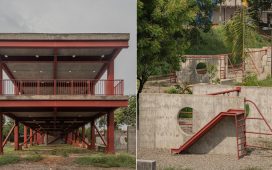Curtain Call installation draws from Woodstock ’69 stage
Curtain Call by office office is the winning design for the 2024 edition of BuildFest at the Bethel Woods Center for the Arts, in New York. Each year, BuildFest invites university faculty teams to design and construct large-scale art installations on the historic grounds of the 1969 Woodstock Festival. This year’s theme challenged participants to explore the intersection of digital and physical construction techniques. Embracing Human-Robot Collaborative Construction (HRCC) techniques, Curtain Call breaks from conventional design and fabrication methods, drawing from the tectonics of the iconic Woodstock ’69 stage.
Designed as a versatile performance space, Curtain Call pavilion features an open-air deck, asymmetrical columns, and a mesh-wrapped roof that adapts to various uses. It accommodates performances, movie nights, pop-up events, and provides a shaded spot for visitors to lounge, picnic, or read. The design reinterprets the wood trusses and fabric canopy of the original Woodstock stage, creating a contemporary structure with fifteen unique trusses forming a dynamic roof. Wrapped in red lightweight mesh, the roof shifts in form and color throughout the day, responding to wind and light. Below, twenty-six asymmetrically arranged columns create spaces of varying sizes, supporting different stage orientations and activities. The integration of computational design tools and structural optimization techniques ensures the pavilion’s innovative structure. Each truss was locally optimized to handle dynamic loads, minimize material waste, and balance tension and compression forces. Reinforced elements in the deck, trusses, and columns provide additional support where loads are transferred, making structural requirements an integral part of the design.

all images by © Alon Koppel/Esto unless stated otherwise
office office’s design blends digital precision with physical craft
The project embraces HRCC techniques, blending digital precision with physical craft. ‘As opposed to fully robotic processes, we became excited and interested in this hybrid approach – the space in between where digital precision and physical craft allow for new material, tectonic, and formal expressions,’ said Jordan Young, co-founder of studio office office. This approach facilitated the creation of a custom, non-repetitive structure fabricated quickly and efficiently. A low-cost timber-marking robot was developed to inscribe fabrication and assembly instructions directly onto each wood member, including cut angles, drill locations, alignments, and unique identification tags. This innovation enabled individuals of all skill levels to easily fabricate and assemble the parts without requiring complex construction documents or on-site coordination. ‘The method we developed allowed materials to act as both a fabrication and assembly guide, eliminating the need for elaborate construction documents and complex on-site coordination,’ co-founder McCarthy explained.
In the four weeks leading up to the festival, all materials were marked, processed, and pre-assembled before being shipped to Bethel, NY. During the five-day live-work festival, faculty and student teams collaborated to assemble and install the pavilion. Curtain Call will remain open to the public at the Bethel Woods Center for the Arts through Fall 2027.

inspired by the 1969 Woodstock Festival, Curtain Call reinterprets the iconic stage’s design

Curtain Call embraces Human-Robot Collaborative Construction (HRCC) for an innovative approach

the pavilion’s open-air deck, asymmetrical columns, and mesh roof create flexible spaces

fifteen unique trusses form a dynamic roof wrapped in lightweight red mesh

twenty-six asymmetrical columns create spaces of varying sizes for diverse stage orientations












